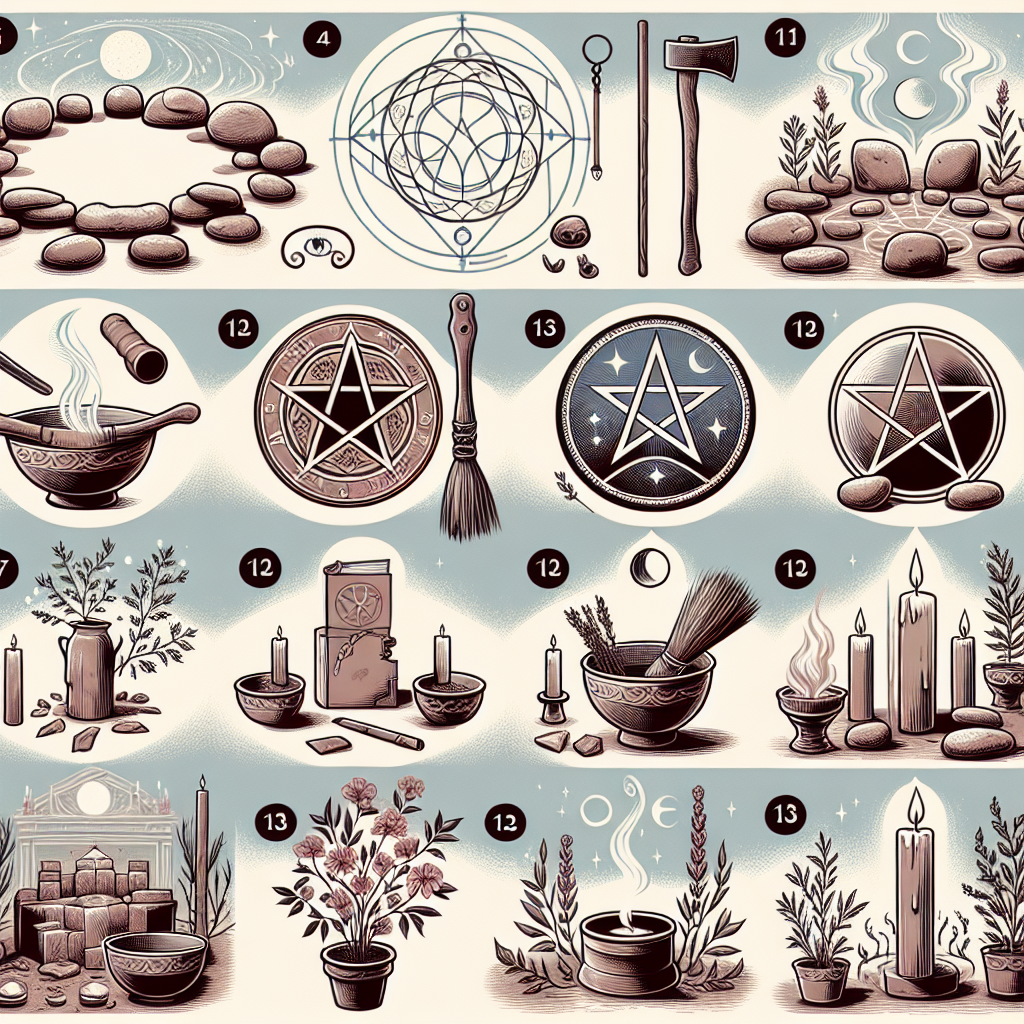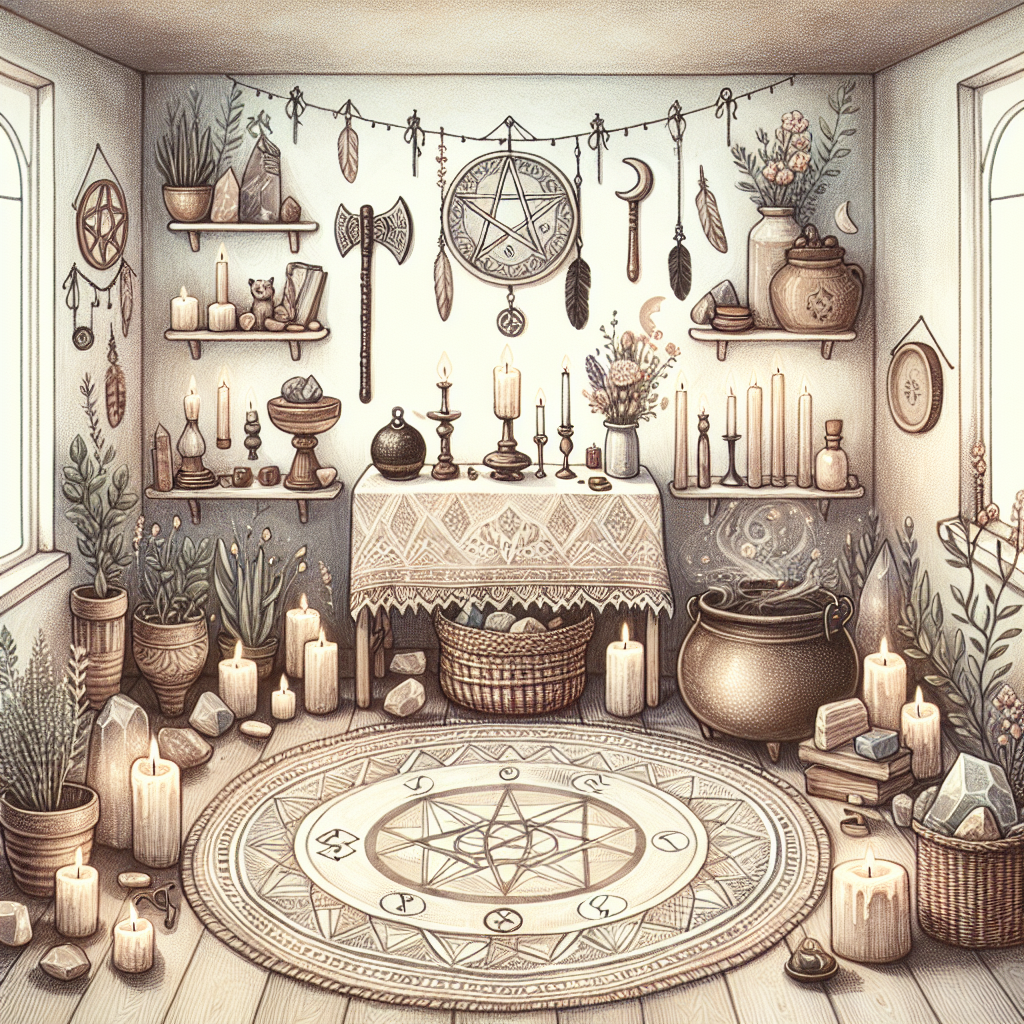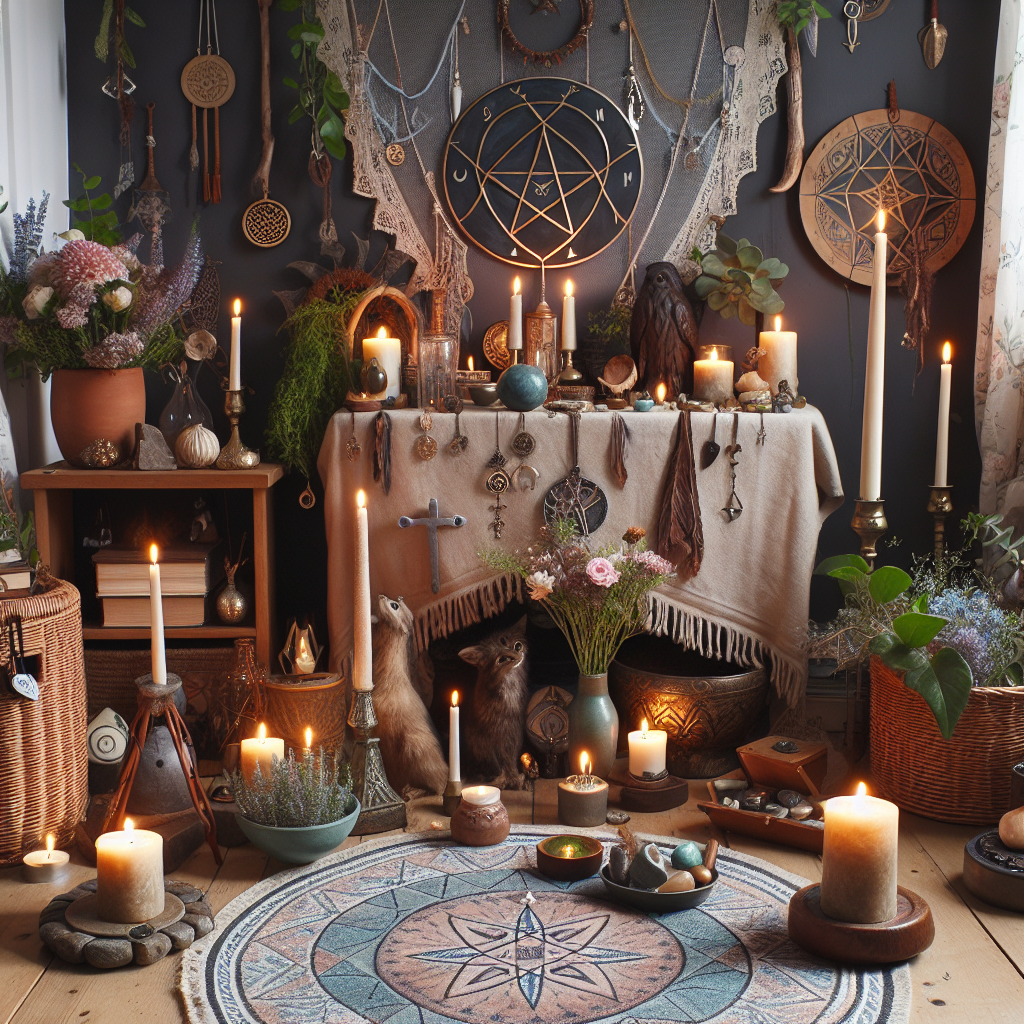As an Amazon Associate I earn from qualifying purchases.

Fifteen Ways to Create a Sacred Space as a Wiccan
Introduction to Sacred Spaces
A sacred space serves as a vital sanctuary for Wiccans, where spiritual work and worship can be conducted in a protected, energized environment. The concept of sacred spaces in Wicca dates back to ancient Pagan traditions where specific locations were consecrated for spiritual activities. With modern Wicca’s rise, the practice of creating personal sacred spaces has gained prominence. According to a survey conducted by the Pew Research Center in 2021, approximately 1 to 1.5 million people in the United States identify as Wiccan or Pagan, signifying the growing interest in these sacred practices.
1. Set Intentions
Setting a clear intention for the space is the first step in creating a sacred area. This helps to focus the energy and purpose of the space, whether it’s for meditation, ritual work, or spell casting.
2. Clear the Space
Physically cleaning and spiritually cleansing the space removes any negative energies. Smudging with sage or using sound cleansing techniques, such as ringing a bell, are commonly used methods.
3. Determine the Boundaries
Defining the physical dimensions of the sacred space helps in creating a contained energy field. This can be done using simple items like stones, ropes, or even visualized energy lines.
4. Use Natural Elements
Incorporate elements like earth, water, air, and fire to balance the space. Plants, water bowls, incense, and candles are traditional items that correspond to these elements.
5. Altar Construction
An altar serves as the focal point for worship and rituals. It can be personalized with statues, crystals, herbs, and other meaningful objects that resonate with your spiritual intentions.
6. Select Symbols
Choosing symbols that resonate with your spiritual beliefs can enhance the sacredness of the space. The pentacle, goddess figures, or other ritual symbols can be displayed prominently.
7. Personalize with Tools
Adding ritual tools like athames, wands, and chalices helps to personalize the sacred space. Each tool should be consecrated and dedicated to its intended purpose within the space.
8. Incorporate Sound
Sound is a powerful tool for creating a sacred atmosphere. Instruments like bells, singing bowls, or even recorded meditative music can be used to set the ambiance.
9. Add Lighting
Lighting plays a crucial role in defining the mood of a sacred space. Candles, fairy lights, or even natural sunlight can be used to create a warm, inviting atmosphere.
10. Use Aromatherapy
Aromatherapy can uplift the spirit and purify the space. Essential oils, incense sticks, or fresh herbs like lavender and rosemary can be used for their cleansing properties.
11. Incorporate Sacred Texts
Sacred texts, such as the Wiccan Rede or Book of Shadows, can be placed within the space. These texts serve as a source of inspiration and guidance.
12. Focus on Comfort
Comfort is essential for a sacred space. Adding cushions, blankets, or comfortable seating allows for extended periods of meditation or ritual work without physical discomfort.
13. Create a Ritual Routine
Establishing a regular ritual routine within the sacred space helps to maintain its energy. Whether it’s daily prayers, weekly rituals, or monthly ceremonies, consistency is key.
14. Invite Nature
If possible, create an outdoor sacred space surrounded by nature. Gardens, groves, or even a small balcony with plants can provide a natural sanctuary for spiritual activities.
15. Maintain the Space
Regular maintenance, both physical and spiritual, ensures that the space remains sacred. This includes routine cleaning, re-energizing rituals, and periodically updating the items and tools within the space.
1. **Select a Dedicated Area**: Choose a location in your home that can be consistently used for spiritual purposes. This could be a corner of a room, a small alcove, or even an outdoor garden space. Having a designated sacred space helps to maintain the energy purity required for Wiccan practices.
2. **Cleanse the Space**: Before setting up your sacred space, it is crucial to cleanse it of any negative energies. This can be done through smudging with sage, sprinkling salt water, or performing a symbolic sweep using a broom.
3. **Set Up a Wiccan Altar**: An altar serves as the focal point of your sacred space. Use a small table or a wooden surface, and cover it with a special cloth. Items typically placed on a Wiccan altar include statues or representations of deities, candles, crystals, and ritual tools like the athame and chalice.
4. **Incorporate Natural Elements**: Wicca is a nature-based religion, so incorporating elements like plants, flowers, stones, and water is essential. These not only enhance the spiritual energy but also keep you connected to the Earth and its cycles.
5. **Personalize Your Space**: Your sacred space should resonate with you on a personal level. Use items that hold personal significance, such as heirlooms, photographs, or anything that promotes a sense of peace and connection to your spiritual path.
6. **Add Symbolic Decorations**: Decorate your sacred space with symbols that are meaningful in Wicca, such as pentacles, runes, or images of the moon phases. These symbols can help to set the spiritual tone and focus your mind during rituals.
7. **Include Candlelight**: Candles are a potent element in Wiccan rituals, representing the element of fire and illuminating your spiritual space. Use candles of different colors to correspond to different intentions during rituals.
8. **Integrate Crystals**: Crystals have unique energies that can amplify the spiritual ambiance of your sacred space. Common Wiccan choices include amethyst for protection, quartz for amplifying intentions, and black tourmaline for grounding.
9. **Keep it Organized**: A clutter-free sacred space helps maintain positive energy. Regularly clean and organize your spiritual space to ensure that its energy remains pure and conducive to your practices.
10. **Smudge Regularly**: Regular smudging with sage, cedar, or other cleansing herbs helps to keep your sacred space free of stagnant energy. This is particularly important after performing intense rituals or if you feel the energy has become heavy.
11. **Use Incense**: Incense not only smells wonderful but also has a spiritual significance in Wicca. Scents like sandalwood, frankincense, and myrrh can uplift the energy and help you focus during meditative practices.
12. **Incorporate Sound**: Sound can be a powerful tool for clearing energy and enhancing spiritual work. Use bells, Tibetan singing bowls, or even recorded chants and nature sounds to maintain a high vibrational frequency.
13. **Create a Meditation Corner**: Set aside a corner of your sacred space specifically for meditation. This could include a comfortable cushion, a small fountain for water sounds, and calming images or objects to aid in your meditation practice.
14. **Use Seasonal Decorations**: Reflect the Wheel of the Year by changing your sacred space decorations to align with the Sabbats. This practice keeps your space dynamic and connected with nature’s rhythms and Wiccan festivals.
15. **Incorporate Books and Texts**: Wiccan texts, books of shadows, and spiritual literature can serve as invaluable resources. Keep these items within your sacred space as both a reference and a spiritual anchor, enhancing the intellectual aspect of your spiritual practice.
According to recent surveys on spiritual practices, approximately 1.5 million people in the United States identify as Wiccan or Pagan, highlighting the growing interest in creating sacred spaces.
“`html
1. Selecting a Special Location
My journey began in the attic of my childhood home, a place that was rarely visited by others. Its seclusion made it ideal for creating a sacred space. I remember moving old boxes and dusting off forgotten corners to make room for my altar. The rustic wooden beams and dim lighting contributed to the serene ambiance I was aiming for, although it needed more personal touches to feel truly sacred.
Years later, when I moved to my own apartment, I selected a corner of my bedroom. The space was limited, but the size didn’t matter as much as the intention behind it. I hung tapestries and positioned my altar in such a way that it was the focal point. This small corner evolved into my spiritual sanctuary, distinctly separated from the mundane aspects of life in the rest of the apartment.
Currently, I have a small backyard that serves as my sacred space. The natural elements, including the chirping of birds and the rustling of leaves, add an extra layer of magic. Positioning my altar near a large oak tree has enriched my rituals, grounding me in nature more profoundly than I could have in an indoor setting.
2. Gathering Sacred Tools
The first items I ever consecrated for my practice were a simple candle, a bowl for water, and a small bell. Collecting these tools one by one felt like an initiation into a deeper world. Each item carried a significance, not because of its material value, but because of the intention and energy I placed into it.
Over time, my collection of sacred tools has grown. I now have a well-worn athame, a wand made from a branch of the oak tree in my backyard, and a chalice inherited from my grandmother. Each tool has a story and a purpose, and arranging them thoughtfully on my altar brings a sense of completeness to my sacred space.
Even after years of practice, I still find joy in searching for new tools. Recently, I added a selenite crystal to my collection, its luminescence adding a calming energy to my rituals. Whenever I introduce a new tool, I spend time cleansing and consecrating it, thereby integrating it into the existing energy of my sacred space.
3. Incorporating Nature Elements
Early in my practice, I discovered the power of incorporating natural elements like stones, leaves, and flowers into my sacred space. Collecting these items from hikes and walks made me feel more connected to the earth. I remember the first time I placed a special river stone on my altar, feeling its grounding energy flow through my practice.
The changing seasons also play a significant role in my sacred space. During the spring, I adorn my altar with fresh flowers and budding leaves. In the fall, acorns and colorful foliage find their place on my altar, reflecting the natural cycle and its corresponding energies. These seasonal changes keep my practice dynamic and in harmony with nature.
I also enjoy incorporating elements like feathers and shells that I find during my travels. Each item is a memento, carrying the energy of the place it was found. These elements make my sacred space not only a center for ritual but also a tapestry of my personal journey and connections to the earth.
4. Setting Intentions
Setting intentions has been a cornerstone of creating my sacred space. Before any ritual, I take a moment to ground myself and verbalize my intentions clearly. This simple but powerful act transforms my space into a conduit for manifesting my spiritual and personal goals. My intentions act as the foundation upon which everything else in my sacred space rests.
In the beginning, my intentions were centered on protection and guidance, basic needs for someone new to the path. As my practice deepened, I began setting more specific intentions for growth, love, and abundance. This evolution mirrored my personal growth, making my sacred space a living reflection of my spiritual journey.
Now, I make a habit of writing down my intentions and placing the paper under a crystal on my altar. This physical act of recording my intentions serves as a reminder and adds an extra layer of energy to my manifestations. The sight of these written intentions anchors me in my practice, reminding me of my progress and the power of my sacred space.
“`
u003ch2u003eWhat is a sacred space in Wicca?u003c/h2u003e
u003cpu003eA sacred space in Wicca is a dedicated area where practitioners can connect with their spirituality, perform rituals, and focus on their spiritual practices. It is a place of tranquility, away from the distractions of daily life, where one can meditate, reflect, and invoke the presence of deities or other spiritual entities.u003c/pu003e
u003ch2u003eWhy is it important to have a sacred space?u003c/h2u003e
u003cpu003eHaving a sacred space is crucial for Wiccans as it helps to create a clear boundary between the mundane and the spiritual. It fosters a sense of peace and reverence, making it easier to concentrate, meditate, and perform rituals effectively. This dedicated area serves as a physical and spiritual anchor, helping to enhance one’s spiritual practices.u003c/pu003e
u003ch2u003eWhere should I set up my sacred space?u003c/h2u003e
u003cpu003eYour sacred space can be set up anywhere that feels private and comfortable. It could be a corner of your bedroom, a dedicated room, or even an outdoor area like a garden. The key is to choose a location that allows you to feel undisturbed and at peace.u003c/pu003e
u003ch2u003eWhat items should I include in my sacred space?u003c/h2u003e
u003cpu003eItems in a sacred space often include an altar, candles, incense, crystals, flowers, and representations of the four elements (earth, air, fire, and water). You might also want to include symbols of your deities, a Book of Shadows, ritual tools such as an athame, chalice, or pentacle, and any personal spiritual items meaningful to you.u003c/pu003e
u003ch2u003eHow do I create an altar in my sacred space?u003c/h2u003e
u003cpu003eTo create an altar, you can use a small table, a shelf, or even a cloth-covered box. Place on it items that hold spiritual significance to you, such as statues or images of deities, candles, crystals, and ritual tools. Arrange them in a way that feels harmonious and meaningful. You can also change the items on your altar to reflect different sabbats and spiritual needs.u003c/pu003e
u003ch2u003eCan I have a portable sacred space?u003c/h2u003e
u003cpu003eYes, a portable sacred space can be created using a small box or bag. Inside, you can keep miniatures of your ritual tools, a small altar cloth, candles, crystals, and any other small items that help you connect with your spirituality. This allows you to set up a sacred space wherever you go.u003c/pu003e
u003ch2u003eHow often should I use my sacred space?u003c/h2u003e
u003cpu003eUse your sacred space as often as feels right for you. Some Wiccans visit their sacred space daily for meditation and reflection, while others may use it primarily for rituals, spells, and seasonal celebrations. The frequency is entirely personal and should fit your spiritual and practical needs.u003c/pu003e
u003ch2u003eCan I share my sacred space with others?u003c/h2u003e
u003cpu003eYes, you can share your sacred space with others if it feels appropriate. Some Wiccans perform group rituals or invite friends and family to join in certain celebrations. However, make sure that anyone entering your sacred space understands and respects its spiritual significance.u003c/pu003e
u003ch2u003eHow do I cleanse my sacred space?u003c/h2u003e
u003cpu003eTo cleanse your sacred space, you can use methods such as smudging with sage or incense, sprinkling salt water, or using sound like a bell or singing bowl. The purpose is to remove any negative or stagnant energy and to refresh the space, making it conducive for spiritual work.u003c/pu003e
u003ch2u003eCan my sacred space change over time?u003c/h2u003e
u003cpu003eAbsolutely. Your sacred space can evolve as your spiritual journey progresses. Feel free to rearrange, add, or remove items based on your current needs, seasonal changes, or new insights. This flexibility allows your sacred space to remain a true reflection of your spiritual path.u003c/pu003e

Conclusion
Creating a sacred space as a Wiccan involves thoughtful integration of natural elements, intention, and personalized touches that resonate with your spiritual practice. The article emphasized the importance of selecting and consecrating a Wiccan altar, which serves as the centerpiece for your spiritual activities. Whether you’re using crystals, herbs, or symbolic items, each component of your altar is chosen to amplify your energy and focus. Regularly cleansing your space using elements like sage or salt is crucial in maintaining a powerful, positive atmosphere. As each sacred space is unique to its creator, personal touches such as handmade tools, altar cloths, and meaningful symbols further empower the spiritual zone, reflecting your path and facilitating a deeper connection with the divine.
In addition to the physical elements, incorporating daily rituals and mindfulness techniques within your sacred space enriches your Wiccan practice. The article detailed various methods such as meditation, spell work, and seasonal rites, all of which can be conducted within your designated ritual area. Establishing a sacred space within your home encourages a consistent, grounded practice that aligns with natural cycles and personal growth. By integrating these practices into your living space, you cultivate an environment that not only honors the traditions of Wicca but also supports your individual spiritual journey. The act of consciously creating and maintaining a sacred space ultimately reinforces the bond between the practitioner and their spiritual path, fostering a sense of serenity and purpose.
Amazon and the Amazon logo are trademarks of Amazon.com, Inc, or its affiliates.


